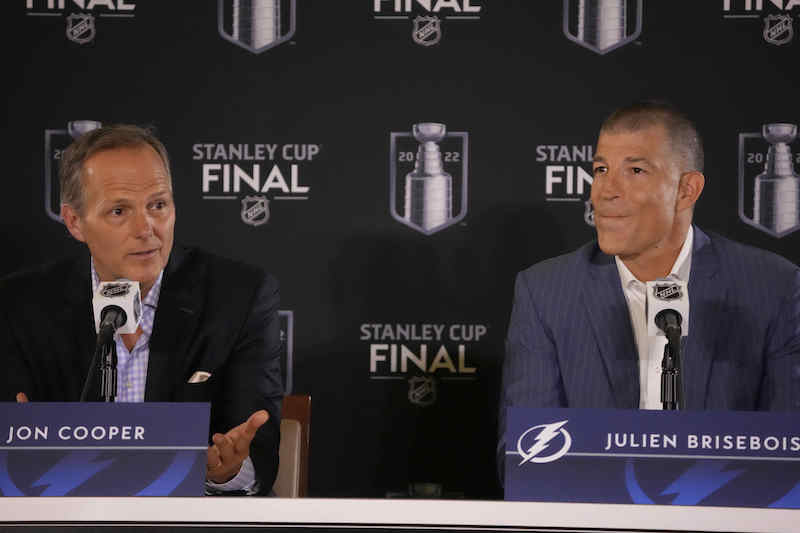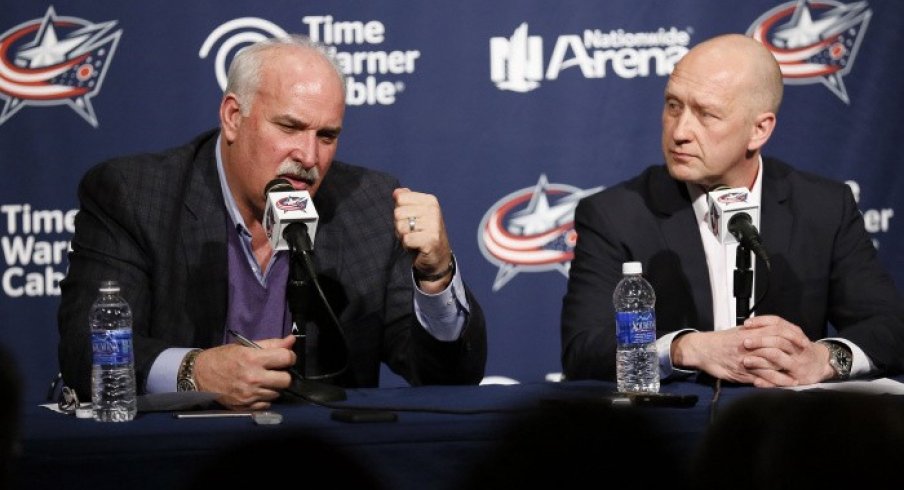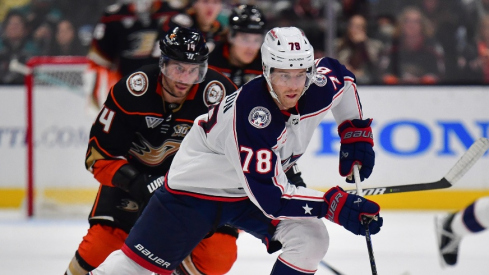Looks like we have a series now.
In the middle of a Stanley Cup Final featuring arguably the two best teams, the Tampa Bay Lightning and Colorado Avalanche, an interesting element behind these perennial powers came to mind: How each team got here in the salary cap age.
In professional sports, every team (for the most part) looks to construct a roster that can contend year in and year out and ultimately compete for a championship. A simple concept in theory, yet much harder in reality. One common goal with a myriad of ways to get there, though the elite teams tend to follow similar blueprints.
The NHL salary cap has been in place since its 2005 inception and has the intention to help create parity—at least provide that illusion—to foster competitiveness and provide the hope, especially for 32 respective fanbases, that all teams can compete year in and year out.
Despite how hard it is to build championship teams from season to season with the salary cap in place, the Lightning has managed to do just that. Let alone dominating regular seasons and becoming a formidable Stanley Cup participant over a period of years.
The Lightning are the first team to win consecutive Stanley Cups in the salary cap era since the Pittsburgh Penguins in 2015-16 and 2016-17. With four Final appearances since 2014-15, when they lost to the Chicago Blackhawks, the Lightning look to steer themselves out of consecutive 2-0 and 2-1 series deficits in these playoffs to hoist their third straight Cup.
On the other side, the Avalanche are among the recent rebuild success stories that went from a league-worst 48-point season in 2016-17 to making the playoffs every year since and becoming more powerful along the way.
As our Dan Dukart illustrated recently, both the Lightning and Avalanche have built up their respective rosters in such a way that few teams can seriously contend with them.
So how did each team fortify themselves to this degree?
Excellent front offices, coaching, talent, and depth aside, you can point to common denominators. And it's the first step on the blueprint that teams like the Columbus Blue Jackets are starting with.
Building up their core foundation through the draft.
Both the Lightning and Avalanche struck it rich in the draft, finding franchise cornerstones that include great depth players, All-Stars, and future Hall of Famers. The Blue Jackets hope for similar luck in that their findings, such as Cole Sillinger and Kent Johnson, turn out to be the franchise building blocks that put the team on a winning trajectory.
And as dominant as the Lightning and Avalanche are now, they too, had their foibles. The Lightning won it all with John Tortorella in 2004 but then ran through a span of four head coaches from Tortorella to Barry Melrose for 16 games, to Rick Tocchet for just under two full seasons, to Guy Boucher, before finding stability with Jon Cooper that started in the middle of the 2012-13 season.

Among the Lightning's championship core, they've drafted and honed talent in the form of players like captain Steven Stamkos drafted first overall in 2008, Victor Hedman with the second pick in 2009, Nikita Kucherov in the 2011 second round, Ondrej Palat in the 2011 seventh round, Andrei Vasilevskiy in the 2012 first round, and Brayden Point in the 2014 third round. Then they agreed to long-term extensions with Stamkos, Hedman, and Alex Killorn in 2016 to help make their current championship run possible. They also locked up Kucherov in 2018 through 2026-27 and Vasilevskiy in 2019 through 2027-28.
Another multi-point game for Nikita Kucherov:
— NHL Public Relations (@PR_NHL) June 21, 2022
44th of the #StanleyCup Playoffs trailing Sidney Crosby (67) & Evgeni Malkin (53) for the most by active players
7th in the Final, now the most among active players#NHLStats: https://t.co/WF3XQy7NMn pic.twitter.com/k82k1mTL1S
There are some UFA on the Lightning's off-season docket, such as Palat, but with most of their primary core signed, they're poised to be another threat in the Eastern Conference next season.
It took the Avalanche 20 seasons to get back to the Final and they haven't had a lot of lean years in that time between, but they certainly are boosted by star talent as a result of great drafting, especially in recent years because of high draft picks.
Boosted by the likes of hometown talent like Cale Makar taken in 2017 with the fourth overall pick, that pick was acquired from the Ottawa Senators in the same deal that sent Matt Duchene the other way. Captain Gabriel Landeskog was taken with the second overall pick in 2011, Nathan MacKinnon in the 2013 first round, and Mikko Rantanen in the 2015 first round.

They also locked up core pieces like Rantanen in 2019, Makar, and Landeskog in 2021, but will have decisions to make on UFA such as Nazem Kadri and Andre Burakovsky after the season, and MacKinnon is a UFA following the 2023-24 season. Colorado has $25,685,000 in projected cap space per CapFriendly.
There were also the right trades along the way, like acquiring goaltender Darcy Kuemper in 2021, also a UFA after this season. Although goaltending felt like the lone possible weakness for the Avalanche when compared to Vasilevskiy. Now that storyline might be playing out after Kuemper was pulled in Game 3 after allowing five goals in the 6-2 loss following a 7-0 win in Game 2.
Among the Lightning's mid-season trades for depth included bringing in Brandon Hagel from the Blackhawks to bolster themselves for the stretch run.
Laine could be that central trade acquisition for the Blue Jackets although they better figure out a solution in RFA negotiations to keep him happy and in the fold long-term.
When you think about the Lightning's recent run of success, don't consider it a stain that they benefitted from a loophole they've helped expose by placing star players like Kucherov on long-term injured reserve due to hip surgery last year and a lower-body injury this past season.
Because LTIR provides a salary cap exemption for teams in those scenarios, it allowed them the cap space to help keep their main roster core intact, add additional players at the trade deadline, and then get players like Kucherov back in time for the playoffs.
Kucherov leads the Lightning this postseason in points (26) and assists (19) to go with seven goals, and he led the playoffs in points and assists each of the last two postseasons (32—24-8 in 2021-22 and 34—27-7 in 2019-20) without any negative consequences against the cap.
The reason for this is the salary cap currently does not extend into the playoffs so the Lightning are exceeding the salary cap by means of LTIR per CapFriendly.
Which could change in the future, as Pierre LeBrun of The Athletic wrote about in March, but any changes seem unlikely. The Lightning are not the first team to exercise cap gymnastics and won't be the last as long as the current structure is in place. That's just smart cap management. It's a tactic all teams will explore and we saw it work for the Blackhawks in 2015 when Patrick Kane returned for the playoffs, helping them win the Cup over the Lightning. Kane led the club with 23 points and 11 goals in the playoffs.
As the Blue Jackets look to be drafting wisely, and arguably for the first time in their history after terrible drafts and roster moves in the first decade of their existence, they're dead set on building things the right way this time. It helps if the pieces they've drafted become generational players like both the Avalanche and Lightning have seen grow into long-term fixtures for the respective franchises.
The Blue Jackets also need to be better with their negotiations in keeping players, so as to not have a repeat of the Pierre-Luc Dubois saga, which did net them Laine, but the Blue Jackets mustn't risk letting negotiations go awry.
The NHL and NHLPA have confirmed the 2022-23 salary cap range: $82.5M ceiling, with a $61M floor.
— Chris Johnston (@reporterchris) June 16, 2022
With a projected cap space of $21,016,667 per CapFriendly, the Blue Jackets have plenty of resources to build a team within the constraints of the salary cap, which will rise to $82.5 million for next season.

